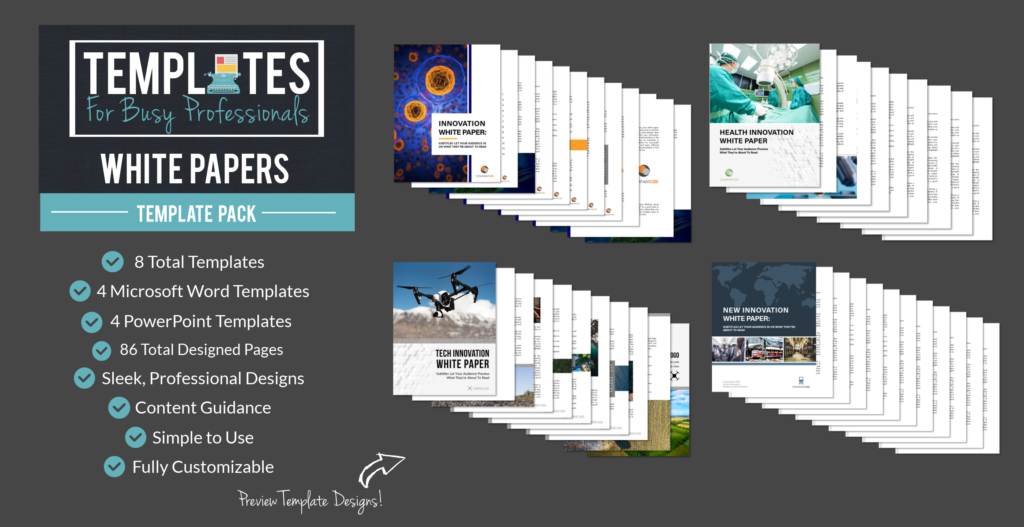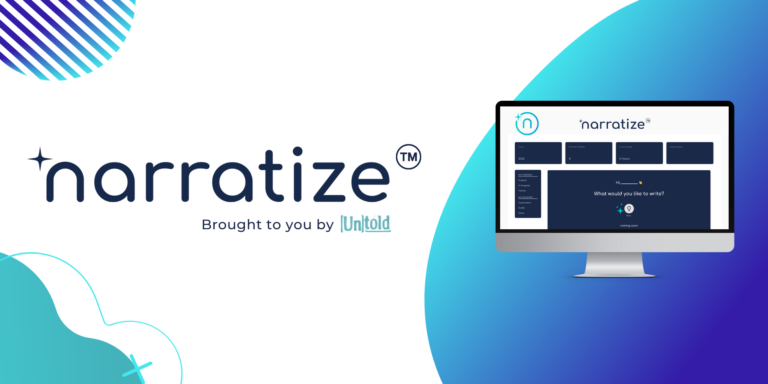Blog >> How to Write a White Paper
How to Write a White Paper
Help inform policy decisions. Establish your reputation as a thought leader. Sell a product. These are just some of the reasons to write a white paper. At once a report and a marketing tool, the white paper is an informative, research-based genre that might also (but doesn’t always) persuade its readers to buy into a new concept or product. In this blog, we will clarify what a white paper is, what it includes, and offer strategies for writing and designing this commonly used, but often-times misunderstood piece.
Unlike more direct marketing materials, such as brochures and product descriptions, white papers persuade readers through well-researched facts about the existing solutions to a problem. By offering better alternatives, white papers can nudge readers to agree that the new product or process is the best option out there. White papers are research-based and informative first, and a persuasive marketing tool second. Just think of them as academic research papers for the business sector.
We have a lot of advice to share in this blog, but if you’re ready to start the writing process, definitely check out our expert-crafted white paper template pack—an exclusive item in our Templates for Busy Professionals™ series.
Now that you understand a little more about what a white paper is, you probably want some guidance on how to write one.
What sections are typically included in a White Paper?
Title
Grab your reader’s attention by choosing a title that communicates the problem and solution (note: do not use the product title in order to avoid the impression of a “hard sell”).
Executive Summary
This is your chance to let your reader know what’s ahead of them, what’s the most important information, and what are the takeaways. Provide a brief summary of the paper, but don’t give a detailed road map. You want your busy readers to know what to expect, but not the minutiae of each section. By writing concisely, using storytelling elements, and not immediately selling your product, you will provide them with enough interest to keep reading.
Opener
This is where you will provide a frame to your discussion. You can take time to describe how things previously worked and your new approach, define the topic, or talk about the trend you have observed.
Background (Optional)
Including a background section in your white paper is optional, depending on how much you have already covered. At this point, you might have already provided enough information to move on. However, if you feel the need to position your innovation further or provide more information on the change, the need, or the topic, this is your chance.
Problem
The problem section of your white paper should directly address the challenges that your readers are facing and allows you to reflect your keen understanding of the pain points or issues your innovation resolves. Your discussion of the problem should be detailed and thorough in order to ensure your readers are on the same page with you before you launch into a solution. This discussion also positions you as an authority in this field who understands exactly how and why your innovation is needed now. Keep in mind that, sometimes, it’s not necessary to explicitly describe the problem within its own “Problem” section. If your Opener or Background section already maps out the challenges and desires that make your solution necessary, then move straight into your solution.
Solution
This is the heart of your white paper and is your chance at displaying your passion for your innovation and its benefits in the industry. Make sure you cover what your innovation actually is, why and how it addresses the problem, and who it is intended for. Consider ways to emphasize your innovation’s benefits, including user testimonials, addressing previous approaches, case studies, or ideas for implementation.
About Us
This is a brief description of your company and your chance to advertise. However, you are not necessarily making a sales pitch, you are telling your readers about your company and its services, but also ensuring that there is a clear connection between who you are and your innovation.
Call to Action
What do you want readers to do after reading your white paper? Take this opportunity to guide them – send them to your website or share contact information. Hopefully by now they want to adopt your innovation, so make it easy for them to do.
Citations/Bibliography
Citation is incredibly important to research-based reports, since your readers want to know that you thoroughly understand the context of the topic. Cite all sources so that your reader can locate them. Check out our advice on citations.
#WritingProTip: As you write your paper, avoid generic titles for the sections—get creative!
Point of View: Design Matters
The content is just one part; paying attention to design is another key aspect to creating an engaging and informative white paper. When it comes to reader engagement, the visual design of a white paper can make all the difference. By honing in on the design, we ensure our information is presented in clear, digestible ways. Here’s something to keep in mind when designing a white paper: Readers do not necessarily read documents word-for-word in a simple, top-down manner. Reading involves fast eye-scanning and browsing just as much (if not more) than reading for details or deep comprehension. That means the organization of information on the page plays a key role in determining what readers choose to read and how much focus they exert in that reading. To ensure that your white papers appeal to busy readers (e.g., C-Suite executives), display information according to the “Three Layers of Reading,” where in each layer, the reader goes more in depth with your piece.
Whether your white paper is internal, external, or both, your readers will come with varying background, experience, and learning styles. To reach them where they are, consider applying modality analysis (read our “Reading Your Audience’s Mind” series) to reach your primary and secondary audiences. Remember that your goal is to persuade your readers to accept a new position, product, or technology.
In terms of white space and graphics, design decisions come down to the type of white paper and target audience. Research-based white papers are dense with information and tend to have fewer graphics since they are targeted at field experts who want to spend a lot of time in the information. Alternatively, white papers that introduce a new technology or offer a solution to high-level problems generally have a more visual design and make better use of white space so as not to crowd their reader with unnecessary details. The trail-blazing urban mobility company, Volocoptor, offers this type of highly designed reader experience in their Pioneering the urban air taxi revolution white paper.
It’s clear that if a white paper is supported with careful research, engaging infographics and quotes, and integrates our tips for modality analysis, readers will be more likely to get on board with the ideas you present and–if you’re writing for a business–become new and enthusiastic customers as well.
Give yourself every advantage when it comes to engaging stakeholders. Check out our White Paper Templates!
If you found this blog helpful, make sure you take a look at our white paper template pack. Our team of expert writers support impactful professional documents that clarify complex ideas and earn stakeholder interest. Whether you need to write marketing materials or a white paper, be sure to check out more of our technical writing services.







